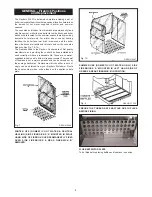
The chimney must be swept before installation.
Erecting New Chimney
The flue through the chimney should be formed with pre-cast
moisture and acid-resistant liners with a minimum internal
dimension of 185mm square and all in accordance with the
current Building Regulations (England and Wales) and in
Scotland the Building Standards (Scotland) (Consolidation)
Regulations and the Codes of Practice for chimneys and flues
BS. 6461 Part 1 and BS 7566 Parts 1 to 4.
Ensure the chimney liners are free of projecting internal
building jointing composition before the appliance is installed.
Factory made Insulated Chimneys
It is recommended the chimney be ceramic lined and comply
with BS. 4543.
The minimum diameter for a straight chimney is 175mm and if
offsets are fitted the recommended minimum diameter is
200mm.
There are two Isokern pumice liners which are also
recommended. One is the standard 175mm diameter and the
other is a 170mm thin wall. The thin wall has a smaller outer
diameter and is designed to fit an existing chimney system.
Both have a lifetime guarantee.
IN ALL TYPES OF CHIMNEYS THE MINIMUM HEIGHT FOR
CORRECT OPERATION OF THE COOKER IS 4.8m AND
SHOULD TERMINATE ABOVE THE ROOF IN ACCORDANCE
WITH REGIONAL STATUTORY REQUIREMENTS.
RECOMMENDED FLUE DRAUGHT - 20Pa/.08 WG MINIMUM.
THE APPLIANCE SHOULD BE INSTALLED AND CONFORM
TO THE CURRENT CODES OF PRACTICE FOR
INSTALLATION OF DOMESTIC HEATING AND COOKING
APPLIANCES BURNING SOLID FUEL - BS 8303.
ALWAYS ADVISE THE USER TO CLEAN THE COOKER
FLUES IN ACCORDANCE WITH THE OPERATING
INSTRUCTIONS AND TO HAVE THE CHIMNEY SWEPT AT
A MINIMUM OF 6 MONTHLY INTERVALS AFTER THE
COOKER IS COMMISSIONED. A VISUAL INSPECTION
SHOULD BE CARRIED OUT MONTHLY.
WARNING: PROLONGED SOOT FORMATION MAY RESULT
IN THE FLUEWAYS BECOMING BLOCKED AND COULD
GIVE RISE TO THE RELEASE OF CARBON MONOXIDE, A
POISONOUS GAS, INTO THE ROOM.
The position of available types of flue layouts are shown in
Figs. 2, 3 and 4, the cooker flue chamber is adaptable to
provide either top or back flue outlets, by means of the
reversible loose socket.
(a)
Rear Flue Outlet
This must only be used where there is a brick flue
immediately behind the cooker. Provision must be made for
a condensate collecting vessel and cleaning door. See Fig. 3.
NOTE:
EXTENDED REAR FLUE PIPE AND BENDS ARE NOT
RECOMMENDED.
(b)
Top Flue Outlet
The cooker should be connected to the main flue via a
150mm minimum diameter cast iron pipe or appropriately
sized vitreous enamelled mild steel pipe and be sealed to
the cooker flue chamber with soft rope and fire cement.
Any bends in the flue pipe must be not less than 135º (45º
from horizontal) and be complete with a cleaning door.
A minimum 6” vertical length of flue pipe must be fitted before
any bend is included.
Fig. 2
Fig. 3
Fig. 4
3
DESN 515206
DESN 515207
DESN 515208 A
COOKER FLUE CONNECTION


























